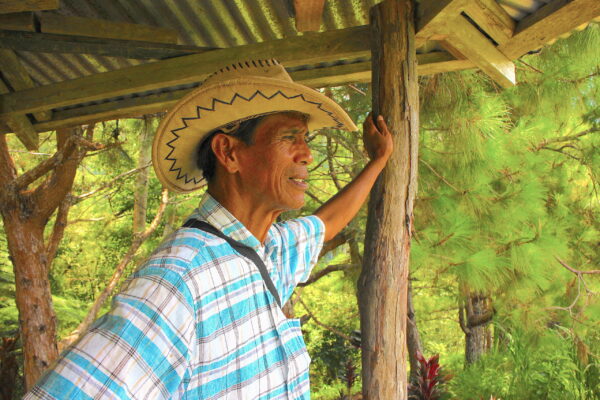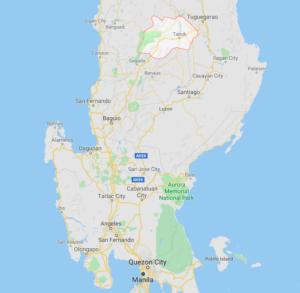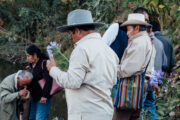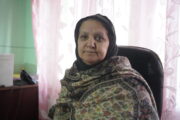This article was published with the support of CRCC’s global project on engaged spirituality.
The buoyant chatter of children drifted down from a wooded ridge as we pulled up to the teaching farm. A well maintained trail led us from the parking area past a few rustic buildings, then above rows of farming terraces that descended to the base of the ridge.
Cirilo “Sapi” Bawer offers instruction on blending sustainability into traditional agricultural practices at the farm, one of the sites of Bawer’s work as a culture-bearer for the Kalinga, an indigenous group that inhabits the mountainous Cordillera region of the northern Philippines.
Children filed past us as we ascended the trail to the ridge overlooking the farm and the broad Chico River valley. Bawer told me that it was not traditional farming they had come to learn: Teachers from the village elementary school bring their students to the farm because the ridge above it provides an unobstructed view of a new cellular tower on the far side of the valley.
“This is the only place near the village where the kids can get the Internet,” Bawer said.
When we reached the top of the ridge, Bawer–a tall, lean man in his mid 70s–took a seat at a picnic table shaded by pine trees. A few minutes later, one of his grandsons brought up a typical Kalinga lunch of rice, beans, boiled pork and chayote (a squash-like vegetable).
As we settled into our meal, Bawer gazed across the lush valley and remarked, “Why would you think you have to open a book to find God?”
Bawer explained that God, called Kabunyan by the people of the Cordillera, is everywhere. “I know the body of Christ in rice and chayote,” he said.
As a culture-bearer, Bawer has devoted his life to preserving Kalinga rituals, cosmology and folkways to ensure their transmission to future generations. He scoffs at the notion that the Spanish conquistadors, Catholic missionaries or American imperialists were bringing “civilization” when they ventured into a region known both for the ruggedness of its terrain and the fierce independence of its inhabitants.
“We were already civilized,” he said. “You say you are preaching the word of God? It is written in the hearts of men.”
He added, “That’s why my God should not be white! Easier for my God to be brown. We want to join the God who struggles with us.”
Bawer said that, like the colonizers of the past, the consumers whose appetites drive the machinery of global capitalism are “robotized” by behaviors and beliefs that they never stop to question. These unthinking “robots” never reflect on the divine truth written in the human heart and reflexively oppress those who resist assimilation.
“The systems that hold us captive do not make us more human,” he said as he gestured toward the distant cellular tower. “This is my struggle now.”
It is tempting to see indigenous people like the Kalinga as fellow travelers in wider, non-indigenous movements of resistance to global capitalism. That would be a mistake. A closer look at the Kalingas’ struggle shows that spiritual rootedness in a particular place, rather than advocacy for universal anti-capitalist values, is the animating force behind their opposition to colonization. For non-indigenous groups seeking allies in the fight against global capitalism, the history of the Kalinga offers a useful lesson: Not needing to see the zeal for your own movement mirrored in the eyes of your ally is the mark of a liberated mind.
The Sword, the Cross and the Ethnographer’s Notebook
Forty years ago, the Kalingas’ struggle was against Ferdinand Marcos, the right-wing dictator who ruled the Philippines from 1965 to 1986. The Marcos regime wanted to build four dams along the Chico River in Kalinga (outlined in red on the map) and Mountain provinces–an area roughly the size of Delaware. Opposition to the dam project–which would have displaced about a third of the region’s 300,000 people–created an unprecedented alliance among the indigenous groups of the Cordillera, including the Kalinga.
That united front formed the Cordillera People’s Liberation Army. The indigenous militia then joined forces with a communist guerrilla movement that flourished in the Cordillera for the duration of Marcos’ right-wing government, which lasted from 1965 until his ouster in 1986.
“There were many bloody skirmishes here,” Bawer recalled about that time.
The alliance between a pan-Igorot (“mountain people”) indigenous rights movement in the Cordillera and communist partisans hiding out in the Cordillera’s densely forested mountains was a central focus of research for Nestor Castro, a professor of anthropology at the University of the Philippines, who became a deeply embedded participant-observer in the world of the Kalinga and their communist allies.
“Especially in upland and interior areas,” Castro said, “the government there is just symbolic.”
As a college student, Castro traveled to the Kalinga homeland to observe the peace pact ritual that united the tribes of the Cordillera against proponents of the Chico River dam project. Castro explained that the peace pact, or bodong, is a distinctive element of Kalinga culture–a way of managing conflict among warrior clans that can exact deadly vengeance against transgressors.
“Of course, the Americans established roads and built schools,” Castro said. “But the key thing that they adapted in the Cordillera is the use of the peace pact. Their pacification campaigns would include the broad use of the peace pact system.”
Though Spain ruled the rest of the Philippines from 1565 to 1898, the Kalinga and other indigenous groups in the Cordillera were never successfully colonized. Following Spain’s defeat in the Spanish-American War of 1898, the president of the short-lived First Philippine Republic ruled for 10 weeks from the Lubuagan municipality–a cluster of eight Kalinga villages, including Sapi Bawer’s home village–before he was captured by the Americans. The United States occupied the Philippines from 1898 to 1946.
“The Americans were ultimately more successful in colonizing the Kalinga and other Igorots because they adapted their cultural practices,” Castro said. “Unlike the Spanish, who came with the cross and the sword.”
That process of adaptation was facilitated by the research and advice of American social scientists, who began to venture into the Cordillera to study the cultures of its inhabitants within the first few years of American rule.
During this time, the Congregation of the Immaculate Heart of Mary (CICM), a Belgian Catholic missionary society, established churches and parochial schools in the Cordillera, succeeding where Spanish missionaries had failed by adapting their strategies to accommodate–and partly absorb–the indigenous cultures of the Cordillera.
“In terms of religion there would be this interface–in anthropology, we will call it syncretism–of Catholic and indigenous beliefs,” Castro said. “Like, the traditional skirt is worn [by women] in church, and the traditional chant is used in masses.”
The Japanese briefly ousted the Americans and occupied the Philippines during World War II, eschewing adaptation and syncretism in favor of the sword. The Kalinga, in turn, dealt with the Japanese garrison that occupied the American-built school and CICM mission in Lubuagan as they had dealt with Spanish incursions during the previous three centuries. The villagers retreated to hidden redoubts in the forests above the Chico Valley, and Kalinga warriors began to test the defenses of the garrison and kill Japanese scouts.
Soon the sound of Kalinga war gongs, ornamented with the jawbones of slain Japanese soldiers, echoed through the valley–reminding the Cordillera’s latest would-be colonizers that they were attempting to hold complex terrain, defended by indigenous headhunters, for whom the land itself is sacred.
On May 12, 1945, fighter planes of the United States Army Forces in the Far East (USAFFE) bombed the Japanese garrison at Lubuagan. Then the villagers descended from the forest en masse and hacked the survivors to death with machetes.
Cirilo “Sapi” Bawer’s mother was not part of the melee on May 12. She remained in the forest to give birth to Sapi, whose nickname is a Kalinga rendering of USAFFE.
Innocence and Education
Sapi Bawer is a morning person. On the second day of my visit, we agreed to meet at the big, round Bawer family dining table before dawn, which would give us about an hour and a half to talk before the kitchen filled with the bustle and clatter of breakfast.
We drank mild, lightly sweetened coffee from one of the large thermos bottles that had been prepared the night before. Every home we visited in Mabilong–the oldest settlement in the Lubuagan municipality–had similar thermoses at the ready for anyone who might stop by for a visit.
As we began our conversation, roosters crowed nearby, and village dogs offered their commentary on the new day. In the washroom next to the kitchen, water from a spring-fed pipe steadily gurgled into a large sink.
When I remarked on the peaceful vibe, Bawer said that the simple rhythms of village life are a reflection of divinity for him. He described his childhood in Mabilong as “the innocence of paradise.”
Bawer and his family lived for the first years of his life in a traditional A-frame timbered house, with livestock penned beneath an elevated communal living space, where soot from the cooking fire blackened the interior planks and timbers .
When he started grade school at the CICM mission in Lubuagan, Bawer learned to write his clan name using the Roman alphabet.
“The Kalinga people cannot write their language or dialect,” Bawer explained. “My grandfather was a hunter, and ‘Bawer’ means a stick that’s attached to a trap to catch birds and wild four-legged animals. So, in memory of this practice, they said Bawer is my name.”
After attending public middle school and Protestant high school, Bawer earned a degree in education at St. Theresita’s, a local CICM college (mission and vision statement pictured at left).
Concurrent with his Catholic, Protestant and secular instruction, Bawer was learning Kalinga religion and folkways from elders in his clan. By the time he reached college, he had gained local renown as a powerful performer of Kalinga ritual dance.
In 1967, Sister Aurora Zambrano, the major superior of the CICM congregation that administered the school, tapped Bawer to represent the Kalinga at the national indigenous theater company, which would stage a televised performance in Manila.
“Sister Aurora was very progressive,” Bawer said. “She understood the plight of indigenous people.”
1967 was a year of high-points in Bawer’s life: He married Maria, with whom he would have eight children and 22 grandchildren. He also graduated from college and took the first steps on his path as a bearer of the torch for his culture.
It was also the year that his innocence was shattered.
He and Maria—a descendant in a lineage of Kalinga shamans—were married by a shaman in a traditional Kalinga ceremony. That was a step too far in the eyes of the local Catholic hierarchy. Bawer was expelled from St. Theresita’s, and only when he and Maria agreed to have their marriage sanctified by a Catholic priest was he allowed to return.
Then, during his trip to Manila, Bawer was waiting in the wings at a television studio along with other performers in the indigenous theater company, dressed in the traditional woven loincloth of a Kalinga dancer. He overheard one member of the production crew say to another, in English, “I thought mountain people were supposed to have tails.”
“We are only half-naked people to them,” Bawer said as he recalled the exchange. “They were laughing at us because they think we are too simple, we are not organized enough as a people to be able to understand them.”
In that moment–not long after his and Maria’s humiliation by the Catholic hierarchy in Lubuagan–Bawer saw the dangerous effects of colonizing forces on the minds of those without the capacity for self-reflection.
“They have robot minds,” Bawer said. “Once you have that prejudice where your mind is already closed when you encounter me, that is harmful for me. Why? Because you don’t have the basic element of looking at people through the eyes.”
Seeing others “through the eyes”–not just as objects in one’s field of vision, but as beings like oneself, with minds and emotions akin to one’s own–is the first of three laws that govern the Kalinga way of life. Bawer described “having the eye-image” of another person as a way of connecting to Kabunyan–the divine creator-being in Kalinga cosmology.
“The next law means respect for one who has the same eye-image of a person,” Bawer said. “Third is the rule to discipline yourself, for your health and the environment. These are the three laws that regulate us–this is a moral anchor of our behavior.”
He added, “This was the law that governs the moral conduct and behavior of the people here, before the missionaries came or before Christianity was established. We cannot cut it from my world and daily life because it is our celebration of our life. This is the thing that is written in the heart.”
How does this square with the brutality of Kalinga warfare, not just against outsiders like the Spanish and Japanese, but even between warring Kalinga clans?
Bawer called out the hypocrisy behind the question—noting that the superpower that had instigated the Vietnam and Iraq wars, for example, was responsible for far greater carnage than the Kalinga.
Brutality, Bawer concluded, is in the eye of the beholder.
“This is the way we see justice,” he said. “We don’t just indiscriminately kill because the heads are free or the necks are free. That’s insensible!”
Violence is constrained within ritual, just as the comity sealed by the peace pact is ritualized. The shaman acts as the intercessor between the community and Kabunyan, ensuring that the circumstances of war and peace reflect the moral conduct idealized by the three laws.
For those enacting the rituals, the point is to experience the living presence of the divine and to see their experience as a connection to the deep spiritual past. Bawer said that the costumes and rituals of the Kalinga are meant to symbolize “the indwelling of my ancestors.”
 As sunlight chased away the last shadows in the kitchen, one of Bawer’s daughters and one of his daughters-in-law greeted us and began to prepare rice, eggs and plantains for breakfast. Yana and Czarina (pictured at left)–two of Bawer’s young grandchildren–joined us at the table. They practiced their English a bit and talked about their upcoming day at school. Their commute would be short: The elementary school in Mabilong adjoins the compound where the Bawer clan lives.
As sunlight chased away the last shadows in the kitchen, one of Bawer’s daughters and one of his daughters-in-law greeted us and began to prepare rice, eggs and plantains for breakfast. Yana and Czarina (pictured at left)–two of Bawer’s young grandchildren–joined us at the table. They practiced their English a bit and talked about their upcoming day at school. Their commute would be short: The elementary school in Mabilong adjoins the compound where the Bawer clan lives.
Wrapping up our conversation as the kitchen filled with life, Bawer said, “Many are trying to find something, but they cannot find it, because they’re going outside themselves. The whole answer is you. The whole answer is what Kabunyan has given you. Don’t go and look for the answer outside your own God. Divine eternity is in the stories of the ancestors.”
Over and Out
 The Bawer family home is a testament to Sapi’s role as a bearer of Kalinga culture, not just metaphorically but in a literal sense too. A room set aside for social gatherings contains display cases stocked with archival photographs, along with samples of Kalinga textiles and pottery. From the social hall, a short staircase leads into an even larger space–a former evangelical church–where traditional weapons, looms and musical instruments are stored.
The Bawer family home is a testament to Sapi’s role as a bearer of Kalinga culture, not just metaphorically but in a literal sense too. A room set aside for social gatherings contains display cases stocked with archival photographs, along with samples of Kalinga textiles and pottery. From the social hall, a short staircase leads into an even larger space–a former evangelical church–where traditional weapons, looms and musical instruments are stored.
Late one afternoon, after showing me pictures from one of his dance performances in Manila during the 1980s (“Imelda Marcos was enchanted with us”), Bawer suggested that we go for a walk.
On our ramble through Mabilong, it was apparent that Bawer is almost universally known and respected. His notoriety isn’t solely a function of his prowess as a dancer. Chances are, anyone who attended the CICM mission school before 1996 knew Bawer as the elementary school’s principal or as a classroom teacher. Bawer became a teacher at the school in 1968, the year after his college graduation. He served as principal from 1978 to 1996, ensuring that Kalinga history and culture were woven into the school’s curriculum.
For Bawer, being a culture-bearer entails not only preserving artifacts and traditional knowledge but also ensuring the welfare of the Kalinga themselves.
Bawer’s retirement pension allowed him to purchase the land for the teaching farm that we had visited–with the ridge that offered a view of the new cellular tower. The non-profit organization that he cofounded–called SCODA, an acronym for Salidummay (“festive song”) Community Development Association–sponsors the farm’s education projects.
Bawer and SCODA’s other cofounder, his daughter Ophelia–Czarina’s mother, who lives with her husband and three children in a smaller house on the family compound–manage SCODA. Ophelia, a social worker, serves as president of the organization, which has collaborated with a German foundation to build a small water pumping station and a Swiss NGO to construct a maternal health clinic in Mabilong. SCODA has also partnered with the local municipal government to improve the village’s drainage system and provide public toilets to improve sanitation.
It’s the toilets that Bawer wants to show me on our walk.
By most standards of human development, Mabilong and the other villages of the Lubuagan municipality are quite humble. Houses lack running water; communal water sources are fed by springs or small uphill reservoirs. Chickens and semi wild dogs roam the “village highways”–narrow concrete paths that wind through the steeply terraced housing plots and along open sewage channels. Every family has at least one pig.
In a rocky ravine traversed by a footbridge, a concrete structure next to a creek served as the communal toilet facility for some of the poorest homes in the village. Bawer said that such simple improvements reduce the prevalence of waterborne disease and offer a measure of dignity to people whose lives are already very austere.
We descended through the village to the patchily paved two-lane road that connects the 8,000 residents of Lubuagan to the outside world. Heading south, the road climbed a small hill that offered a sweeping view of Bawer’s history and the heart of Kalinga culture–Mabilong, the oldest village of Lubuagan, where Bawer grew up and where three of his children now live with their families; the mission school where he was educated and subsequently taught; the deep gorge of the Chico River; and the steep mountain ridge separating the upland tribal areas of the Cordillera from the flatlands to the east.
I wondered who would succeed Bawer as a bearer of the torch for his culture. There is much love in his family, and the portion of the Bawer clan that has remained in Mabilong seems to share Bawer’s deep appreciation for the Kalinga way of life. But I did not sense a passionate intensity from any of his children or grandchildren that might match Bawer’s and ensure his legacy as a culture-bearer.
Bawer shrugged off questions about who might follow in his footsteps. He preferred to keep his eyes on the bigger picture.
“We are Nazareth compared to the Roman Empire,” he said. “That’s why it’s continuously a struggle to represent yourself and your values as indigenous people.”
Non-indigenous progressives might interpret that as a declaration of common cause with those who oppose a global capitalist empire. It’s really a plea to respect the specialness of Nazareth.
Nestor Castro, the anthropology professor at the University of the Philippines, remarked that, when the Chico River dam project was cancelled after the ouster of Ferdinand Marcos, the communist guerrillas in the Cordillera expected their indigenous allies to continue to fight against the more benign but still capitalist regime of Corazon Aquino.
“The communists believed their own propaganda,” Castro said. “So they were surprised when Marcos was overthrown, and the mountain people said, ‘Thank you for your support. You can leave us now. We had the common enemy that was Marcos and his machinery. But now we have to continue our own struggle.’”
If you insist on assimilating your ally, you’re just another colonizing robot.
 At the overlook that was the last outbound stop on our evening walk, Bawer gestured toward the terraced villages of Lubuagan and told me that the people who live there maintain the forests and the river because the land and their identity are one in the same.
At the overlook that was the last outbound stop on our evening walk, Bawer gestured toward the terraced villages of Lubuagan and told me that the people who live there maintain the forests and the river because the land and their identity are one in the same.
“They’re good people who just live one day at a time,” Bawer said. “Our needs are simple: just to eat together and be connected with the soil. Plant rice, plant vegetables–we are satisfied. Over and out.”
Nick Street was a senior writer with the USC Center for Religion and Civic Culture.




















